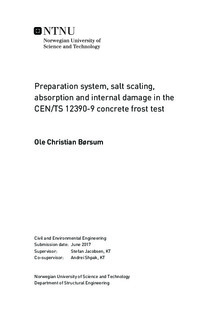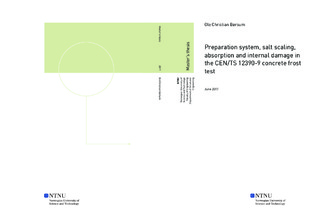| dc.description.abstract | Experiments show that the most promising materials to replace key point 2 and 3 in the CEN/TS 12390-9 standard is by using a combination of Sitko Elastic butyl tape and adhesives. The adhesives are "SikaFlex 11FC" and "Casco Marin og Teknikk Lim og Fug", respectively.
The Experiments show that scaling, absorption and ultrasonic pulse velocity can easily be monitored using the modified setup, basically creating 3 tests for one sample. This can save a lot of time and resources.
The results from Series 2 show that concretes that are not air-entrained har higher scaling and absorption values than the samples that have been air-entrained. This is in compliance with previous research done within this field.
The results also showed that the samples with air-entrainment has a longer durability when it comes to adhesion between the concrete and adhesive/Butyl layer, with samples using air-entrainment scoring higher grades than the ones without when the samples are evaluated. The air entrained concretes are also better at retaining water, as their test surface damages are not as significant as their counterparts.
The rigs tested in the dilatometry pilot project shows that the KylCity freeze/thaw-chamber does not influence the readings made negatively. Distortions when it comes to shaking and internal environment (leakage of water, air moving, etc.) does not influence the results at all.
Part 2 and Part 3 of the test showed that there is a significant difference in dilation when the sample has been exposed to the external air of the chamber or a combination between external air and salt solution on the test surface. The sample in Part 3, which had both salt solution and external air influencing dilatometry had twice as high dilation than the sample in Part 2. The oscillations were also of greater magnitude in Part 3, which might signify that whilst the air plays an important role creating strain, the greatest contributor to large contractions and expansion comes from the water. The motion is anyway combined between the two.
Further looking at the strain/temperature relation shows that the concrete has a CTE between 4,1 to 4,6x10-5, which is significantly higher than the actual value of 0.8 to 1.0x10-5. The values also show that there has been no internal damages of the concrete. | |

